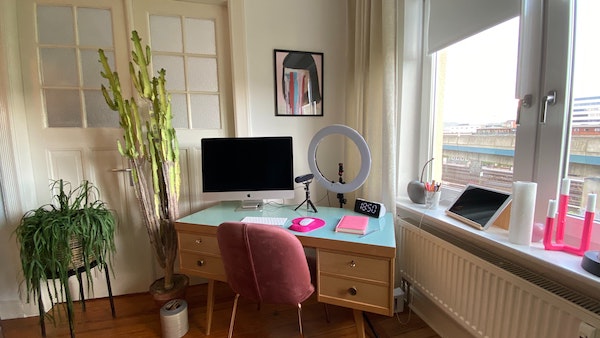
I’m a big fan of YouTube. YouTube and Google have been my biggest allies in providing me with a continuous stream of potential clients interested in learning Spanish.
When I started making videos back in 2011, I was not too fond of it, and it shows. In my defence, I should say that there was less advice about how to do the perfect video, and the microphones, lighting gadgets and other stuff that improves the quality of your video were not as widespread and affordable as it is now.
In any case, I recorded myself regularly answering grammar issues that had appeared during my classes or topics that I found useful. I was tense, I followed a script, and I didn’t dare to do them in English, so I wrote the blog in English and did the videos in Spanish. I used to speak super fast, well, normal pace, but at the beginning, I was less aware of the audience (I didn’t have a big one, maybe my mum and 2 or 3 other people) and because I was so tense, I used to race through my words. Over time, I started to get viewers who very quickly started pointing that out to me. “Speak slowly! I couldn’t get a word of what you said; you were speaking so fast!”
Anyway, as I got more and more learners and my schedule filled up fast, the frequency of my videos decreased, but now, over ten years later, I still get clients who found me on YouTube without having a massive number of subscribers. And for that, I am grateful.
Why should you use YouTube for your language business?
1. YouTube is still the second largest search engine
This means that, after Google, creating a little corner with your content is totally worth it. You may think the competition is huge, and you’d be right. Over 500 hours of video are uploaded to YouTube every minute, so it can be challenging to catch the eyes of your intended audience, but not impossible. And in my experience, perseverance, regularity, and good content always win in the long term. Besides, there are tons of advice about how to optimize your videos to stand out on YouTube.
2. Showcase your skills
Show your face. Let the people get a flavour of you, your ways of teaching, your vibe, and your point of view. Be generous in what you share, and you’ll get the right clients knocking at your virtual door over time.
3. YouTube SEO
YouTube is like Google. It relies on SEO to help drive the best videos to the top. While many content creators start by simply creating, it’s always a good practice to SEO-proof your channel to climb up the rankings: thumbnails, titles, tags, transcripts… All that needs conscious work so that the YouTube gods show your videos to their users, which are a not negligible 2 million people.
Of course, as I mentioned in a previous article, not all your potential audience may speak English or the language you are using in your video, so you can always consider having your video translated into different languages to reach an even wider audience.
4. What you put out there stays out there
Unlike social media, what you upload on YouTube stays there, and if it’s good and people like it, the more you spend time creating and uploading videos, the more you receive long-term. Keyword, long-term. Stop posting stuff on social media for a month, and people will forget about you, and the platform will stop showing your content, which is not the same as YouTube. Of course, you need to publish videos regularly to be shown up in the search, but over time, if your content is good and people engage with it, YouTube keeps showing you years later.
Videos from 2013 (my most prolific year) have still hundreds of views per day, and I am, honestly, not doing much on YouTube at the moment.
5. Create community
You choose how you want to do your videos, but you don’t need to have a huge production and editing. Casual and personable videos are great to get engagement with your audience. Ask them questions, invite them to engage with you in some way, and use the comment section to create and engage with your community. This engagement is gold when it comes to converting viewers into commenters and commenters into clients.
So there you have it, my five reasons why I recommend you to use YouTube videos for your language teaching business.
Do you have a YouTube channel?


